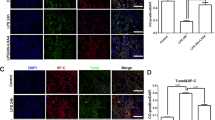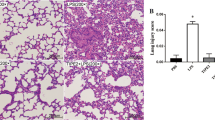Abstract
The aim of this study is to investigate whether silencing of Fas could have an influence on type II alveolar epithelial cell (AEC) apoptosis and inflammatory cytokine production, which prevents alveolar healing after acute lung injury (ALI). Rat primary type II AECs were isolated by elastase cell dispersion and IgG panning. The cells were transfected with Fas-specific small interfering RNA (siRNA) followed by treatment with lipopolysaccharide (LPS), Fas ligand (FasL) or both. The effects of siRNA-mediated silencing of Fas on LPS-induced apoptosis and cytokine release were then assessed. Notably, LPS, either alone or together with FasL, significantly stimulated type II AEC apoptosis and the release of tumor necrosis factor-alpha (TNF-α) and monocyte chemoattractant protein 1 (MCP-1) (P < 0.05 versus the control without treatment). Moreover, the effects exerted by both LPS and FasL were considerably counteracted by pretreatment with Fas-siRNA (P < 0.05 versus treatment with LPS and FasL). In conclusion, inhibition of Fas can diminish LPS-induced apoptosis and inflammatory cytokine production in type II AECs, and Fas specific siRNAs may have therapeutic potentials for intervention of ALI/ARDS.



Similar content being viewed by others
References
Frutos-Vivar F, Nin N, Esteban A (2004) Epidemiology of acute lung injury and acute respiratory distress syndrome. Curr Opin Crit Care 10:1–6
MacCallum NS, Evans TW (2005) Epidemiology of acute lung injury. Curr Opin Crit Care 11:43–49
Brun-Buisson C, Minelli C, Bertolini G et al (2004) Epidemiology and outcome of acute lung injury in European intensive care units. Results from the ALIVE study. Intensive Care Med 30:51–61
Bersten AD, Edibam C, Hunt T et al (2002) Incidence and mortality of acute lung injury and the acute respiratory distress syndrome in three Australian States. Am J Respir Crit Care Med 165:443–448
Rubenfeld GD, Caidwell E, Peabody E et al (2005) Incidence and outcomes of acute lung injury. N Engl J Med 353:1685–1693
Ayala A, Chung CS, Lomas JL et al (2002) Shock-induced neutrophil mediated priming for acute lung injury in mice: divergent effects of TLR-4 and TLR-4/FasL deficiency. Am J Pathol 161:2283–2294
Lomas-Neira JL, Chung CS, Wesche DE et al (2005) In vivo gene silencing (with siRNA) of pulmonary expression of MIP-2 versus KC results in divergent effects on hemorrhage-induced, neutrophil-mediated septic acute lung injury. J Leukoc Biol 77:846–853
Imanaka H, Shimaoka M, Matsuura N et al (2001) Ventilator-induced lung injury is associated with neutrophil infiltration, macrophage activation, and TGF-beta 1 mRNA upregulation in rat lungs. Anesth Analg 92:428–436
Bardales RH, Xie SS, Schaefer RF (1996) Apoptosis is a major pathway responsible for the resolution of type II pneumocytes in acute lung injury. Am J Pathol 149:845–852
Guinee D Jr, Brambilla E, Fleming M et al (1997) The potential role of BAX and BCL-2 expression in diffuse alveolar damage. Am J Pathol 151:999–1007
Vernooy JH, Dentener MA, van Suylen RJ et al (2001) Intratracheal instillation of lipopolysaccharide in mice induces apoptosis in bronchial epithelial cells: no role for tumor necrosis factor-alpha and infiltrating neutrophils. Am J Respir Cell Mol Biol 24:569–576
Perl M, Lomas-Neira J, Chung CS et al (2008) Epithelial cell apoptosis and neutrophil recruitment in acute lung injury—a unifying hypothesis? What we have learned from small interfering RNAs. Mol Med 14:465–475
Matute-Bello G, Liles WC, Steinberg KP et al (1999) Soluble Fas ligand induces epithelial cell apoptosis in humans with acute lung injury (ARDS). J Immunol 163:2217–2225
Matute-Bello G, Winn RK, Jonas M et al (2001) Fas (CD95) induces alveolar epithelial cell apoptosis in vivo: implications for acute pulmonary inflammation. Am J Pathol 158:153–161
Kitamura Y, Hashimoto S, Mizuta N et al (2001) Fas/FasL-dependent apoptosis of alveolar cells after lipopolysaccharide-induced lung injury in mice. Am J Respir Crit Care Med 163:762–769
Perl M, Chung CS, Perl U et al (2007) Fas-induced pulmonary apoptosis and inflammation during indirect acute lung injury. Am J Respir Crit Care Med 176:591–601
Dosreis GA, Borges VM, Zin WA (2004) The central role of Fas-ligand cell signaling in inflammatory lung diseases. J Cell Mol Med 8:285–293
Bem RA, Farnand AW, Wong V et al (2008) Depletion of resident alveolar macrophages does not prevent Fas-mediated lung injury in mice. Am J Physiol Lung Cell Mol Physiol 295:L314–L325
Perl M, Chung CS, Lomas-Neira J et al (2005) Silencing of Fas, but not caspase-8, in lung epithelial cells ameliorates pulmonary apoptosis, inflammation, and neutrophil influx after hemorrhagic shock and sepsis. Am J Pathol 167:1545–1559
Kim HJ, Sammak PJ, Ingbar DH (1999) Hepatocyte growth factor stimulates migration of type II alveolar epithelial cells on the provisional matrix proteins fibronectin and fibrinogen. Chest 116:94S–95S
Marsh LM, Cakarova L, Kwapiszewska G et al (2009) Surface expression of CD74 by type II alveolar epithelial cells: a potential mechanism for macrophage migration inhibitory factor-induced epithelial repair. Am J Physiol Lung Cell Mol Physiol 296:L442–L452
Dobbs LG, Gonzalez R, Williams MC (1986) An improved method for isolating type II cells in high yield and purity. Am Rev Respir Dis 134:141–145
Edelson JD, Shannon JM, Mason RJ (1988) Alkaline phosphatase: a marker of alveolar type II cell differentiation. Am Rev Respir Dis 138:1268–1275
Mizuta M, Nakajima H, Mizuta N et al (2008) Fas ligand released by activated monocytes causes apoptosis of lung epithelial cells in human acute lung injury model in vitro. Biol Pharm Bull 31:386–390
Tafer H, Ameres SL, Obernosterer G et al (2008) The impact of target site accessibility on the design of effective siRNAs. Nat Biotechnol 26:578–583
Juo P, Kuo CJ, Yuan J et al (1998) Essential requirement for caspase-8/FLICE in the initiation of the Fas-induced apoptotic cascade. Curr Biol 8:1001–1008
Nagata S (1997) Apoptosis by death factor. Cell 88:355–365
Wallach D, Varfolomeev EE, Malinin NL et al (1999) Tumor necrosis factor receptor and Fas signaling mechanisms. Annu Rev Immunol 17:331–367
Williams MC (2003) Alveolar type I cells: molecular phenotype and development. Annu Rev Physiol 65:669–695
Sugahara K, Tokumine J, Teruya K et al (2006) Alveolar epithelial cells: differentiation and lung injury. Respirology 11(Suppl):S28–S31
De Paepe ME, Mao Q, Chao Y et al (2005) Hyperoxia-induced apoptosis and Fas/FasL expression in lung epithelial cells. Am J Physiol Lung Cell Mol Physiol 289:L647–L659
De Paepe ME, Gundavarapu S, Tantravahi U et al (2008) Fas-ligand-induced apoptosis of respiratory epithelial cells causes disruption of postcanalicular alveolar development. Am J Pathol 173:42–56
Sharma AK, Fernandez LG, Awad AS et al (2007) Proinflammatory response of alveolar epithelial cells is enhanced by alveolar macrophage-produced TNF-alpha during pulmonary ischemia-reperfusion injury. Am J Physiol Lung Cell Mol Physiol 293:L105–L113
Borges VM, Vandivier RW, McPhillips KA et al (2009) TNF{alpha}Inhibits Apoptotic Cell Clearance in the Lung Exacerbating Acute Inflammation. Am J Physiol Lung Cell Mol Physiol. doi:10.1152/ajplung.90569.2008
Author information
Authors and Affiliations
Corresponding author
Rights and permissions
About this article
Cite this article
Ma, X., Xu, D., Ai, Y. et al. Fas inhibition attenuates lipopolysaccharide-induced apoptosis and cytokine release of rat type II alveolar epithelial cells. Mol Biol Rep 37, 3051–3056 (2010). https://doi.org/10.1007/s11033-009-9876-9
Received:
Accepted:
Published:
Issue Date:
DOI: https://doi.org/10.1007/s11033-009-9876-9




